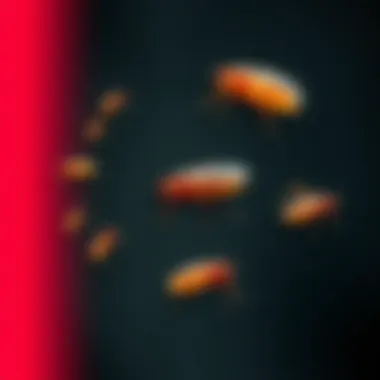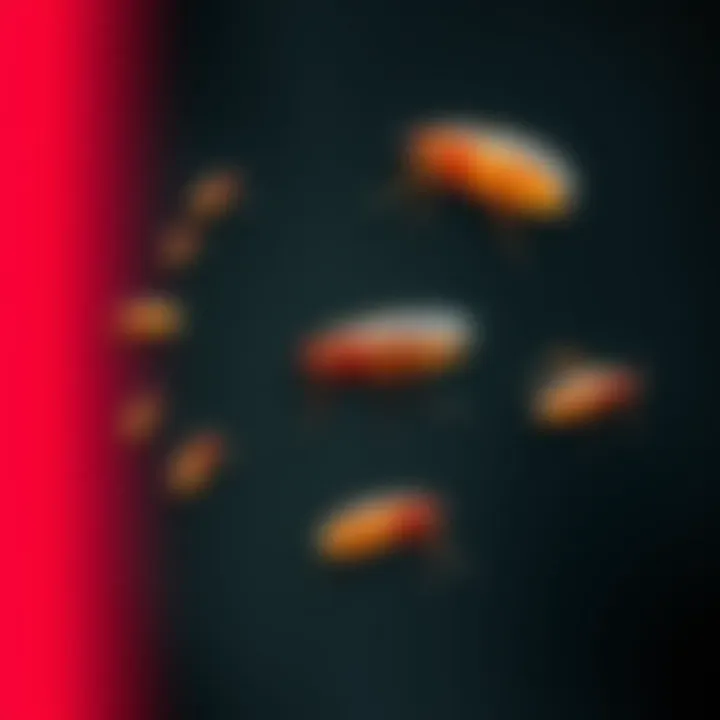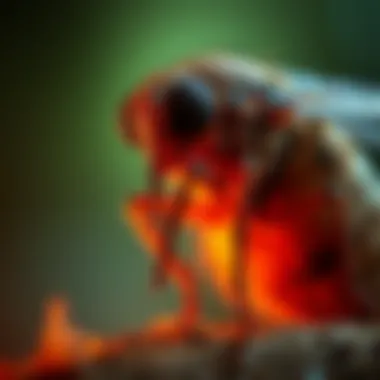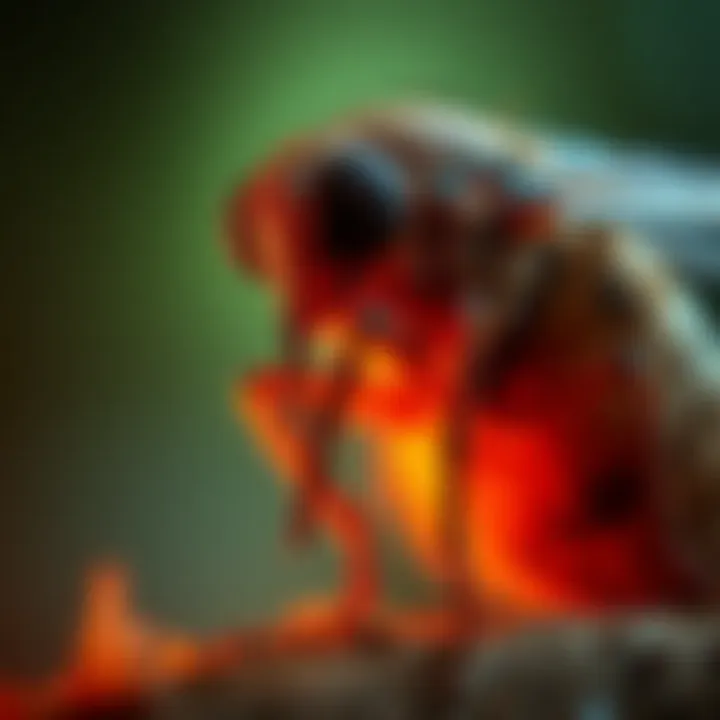Effective Strategies for Home and Yard Flea Control


Intro
Fleas may be small, but their impact is far from insignificant. These tiny parasites not only invade our homes, but also disrupt our lives and our pets’ comfort. Understanding how to treat homes and yards for fleas is crucial for anyone who wishes to maintain a healthy living environment. As the saying goes, an ounce of prevention is worth a pound of cure, and this couldn't be truer for flea infestations.
In this article, we'll delve into the complex life cycle of fleas, identify the signs that usually suggest an infestation, and explore the treatment options available. We will evaluate chemical versus natural solutions, considering how safe and effective they are, along with long-term management strategies. Moreover, we aim to arm you with practical tips on prevention and best practices for creating a flea-free space.
Whether you're a long-time pet owner, a homeowner dealing with these irritants, or simply someone interested in better pest control, you'll find valuable insights here. This article aims not only to inform but also empower you to take control of your environment against fleas. So, roll up your sleeves and let’s get started!
Animal Species Profile
Preamble to the Animal Species
Fleas belong to the order Siphonaptera and are infamous for the troubles they bring. While one might imagine a single flea jumping solo, they often exist in hordes, making their presence far more problematic. Their life can be likened to a bad house guest—unwanted, disruptive, and hard to shake off.
Physical Characteristics and Appearance
Adult fleas are small, usually measuring around 1/8 to 1/6 of an inch long. Their bodies are flattened sideways, which allows them to move easily through the fur of their hosts. The color ranges from reddish-brown to dark brown—almost unnoticeable unless under light. The legs are long and robust, designed for jumping, allowing them to leap up to 7 inches vertically.
Natural Habitat and Distribution
Fleas thrive in various environments, mostly where warm, furry hosts reside. Common locations include homes, gardens, and even indoor spaces like pet shelters. In terms of distribution, fleas can be found worldwide. Some species are tropical, while others are commonly found in temperate regions.
Behavior and Social Interactions
These pests engage in fascinating behaviors. Fleas are not communal but rather solitary outside of mating, relying on the host for food and reproduction. They typically mate on the host and are capable of producing around 25 eggs per day. Their life cycle can range from a week to several months, based on environmental conditions.
Flea Life Cycle
Fleas go through four distinct stages: egg, larva, pupa, and adult. This cycle is crucial to understand when managing infestations:
- Egg: Laid on the host; often falls into bedding or carpeting.
- Larva: Usually found in dark, moist areas; feeds on organic debris.
- Pupa: A cocoon stage where the flea can stay dormant.
- Adult: Emerges seeking a blood meal, usually from a host animal or human.
Understanding these stages is essential for implementing effective treatment. Breaking the cycle is crucial for successfully eliminating fleas, no matter what method you choose.
Treatment Options
When it comes to treating your home and yard for fleas, one can choose from various methods. Below is a comparison of common treatments:
Chemical Treatments
- Insect Growth Regulators (IGRs): Interrupts the development of flea eggs and larvae.
- Adulticides: Such as Pyrethroids target adult fleas quickly and effectively.
Natural Solutions
- Diatomaceous Earth: A natural powder that harms fleas when they come in contact.
- Essential Oils: Options like eucalyptus and lavender can repel fleas.
Utilizing a combination of treatments often yields the best results, especially when preventative methods are regularly implemented.
Preventative Measures
Prevention is simpler than cure. Here are a few tips:
- Regularly vacuum carpets and wash pet bedding.
- Treat pets with veterinarian-recommended flea and tick preventatives.
- Keep outdoor areas clear of debris, which attracts fleas.
- Consider using flea repellents for your yard, such as nematodes, which parasitize flea larvae.
Culmination
To conclude, dealing with fleas requires a comprehensive strategy that combines treatment and prevention. Understanding their biology and habits is as important as knowing your options for eradication. We hope this guide has shed light on effective flea management, paving the way for a future free from these pesky invaders. As a pet owner and home inhabitant, such knowledge ensures that you remain one step ahead in maintaining a healthy environment.
Understanding Fleas
To tackle the overarching issue of fleas in homes and yards, it's vitally important to grasp the core principles surrounding these pesky parasites. Understanding fleas encompasses their biology, habits, and types, which lays the foundation for effective treatment and control methods. This comprehension not only empowers pet owners and homeowners but also equips them with strategies for prevention and eradication. Let's delve into this intricate universe of fleas to highlight their significance in both domestic and broader ecological contexts.
Biology of Fleas
Life Cycle Stages
Fleas undergo a life cycle comprising four distinct stages: egg, larva, pupa, and adult, and each stage plays a crucial role in the overall dynamics of flea populations. Eggs are tiny and can be laid in carpets or on pets' fur, with a single female capable of laying several hundred during her lifetime. The larval stage, which can often be overlooked, thrives in dark, humid environments, such as under furniture. Unlike the adults, larvae feed on organic debris and flea dirt, which makes this stage particularly resilient. Interestingly, pupae can remain dormant for long durations, thus complicating efforts to control an infestation. This cyclical nature of fleas makes understanding their life cycle essential for any treatment plan.
Reproductive Habits
Fleas are known for their prolific reproduction. A female flea can lay up to 50 eggs a day, which adds up to a staggering number of potential offspring over her lifespan. This rapid reproductive rate contributes significantly to the swift establishment of an infestation. What’s more, adult fleas can mate just hours after emerging from their pupal cocoon, ensuring that the lifecycle continues uninterrupted. Knowing about these reproductive habits can help homeowners anticipate and tackle new infestations before they spiral out of control.
Feeding Behavior
Fleas are obligate blood-feeders, meaning they require blood to survive and reproduce. Their feeding behavior is more than just a nuisance; it’s a pivotal factor in the control strategies one might deploy. Adult fleas can consume about 15 times their body weight in blood daily. This not only leads to discomfort for pets and humans but can also transmit various diseases, including tapeworms and other parasites. Understanding their feeding behavior underscores the necessity for swift intervention when an infestation is suspected.
Types of Fleas
Ctenocephalides felis
Commonly referred to as the cat flea, Ctenocephalides felis is the most prevalent species found in homes and is particularly versatile in its habitat preferences. While the name may suggest a tie to cats, these fleas happily infest dogs, humans, and other mammals as well. Their adaptability means that they can thrive in various environments, making them a primary target for pest control efforts. Understanding their habits and prevalence marks an important step in knowing how to further manage flea infestations.


Ctenocephalides canis
As the dog flea, Ctenocephalides canis is closely related to its feline counterpart but has some unique behaviors and host preferences. They predominantly inhabit dogs but can also bite humans and cats. Distinguishing between the two species becomes increasingly important, especially for targeted treatment methods. Each type requires specific attention, be it in chemical or natural treatments, to effectively handle their specific behaviors. Recognizing Ctenocephalides canis is thus a beneficial pathway in the intricate web of flea treatment.
Others
While the cat and dog fleas are the most notorious, there are several other less common but equally disruptive flea species, including the Pulex irritans, or human flea. These species vary in their adaptations and preferences, presenting different challenges in management. The diversity of flea types means that a one-size-fits-all approach in treatment will likely fall short; understanding these nuances provides homeowners and pet owners with comprehensive tools to combat flea issues and achieve effective eradication.
Identifying Flea Infestations
Recognizing flea infestations is crucial for effective pest control. By spotting the signs early, pet owners and homeowners can combat invasive fleas before they spread. Knowing what to look for can save a lot of trouble down the road, avoiding unnecessary discomfort for pets and family members. In this section, we will cover the important signs indicating flea presence both in animals and within the home itself.
Signs of Fleas in Animals
Scratching and Biting
When fleas latch onto pets, they often cause intense itching. This scratching and biting is a direct response to the irritating bites of fleas. Pets may scratch at their ears, tiles of their legs, or even gnaw at their skin, trying to relieve the itch. This behavior is a significant indicator of flea issues.
The main characteristic of this symptom is its consistency. Pet owners might observe their animals behaving differently—restlessly roaming around or refusing to settle down. It’s not just a nuisance; it can also lead to skin infections if left unchecked, making it vital to act quickly.
However, one must tread lightly. While scratching might indicate fleas, it can also point to other skin issues or allergies. Correct identification is necessary to ensure effective treatment.
Flea Dirt
Flea dirt is a potent sign of infestation that should not be overlooked. This term refers to the flea feces, often looking like small black specks that can be found on pet fur or in their bedding. The presence of flea dirt is a clear indicator that fleas are around.
A key characteristic of flea dirt is that it often resembles ground pepper. When moistened, it turns a reddish-brown color due to the digested blood content. Noticing this in your home often serves as a wake-up call, urging action.
However, it’s important to understand that while flea dirt can inform owners of a flea problem, it does not elucidate the scale of the infestation. Even small amounts might indicate a larger problem, thus requiring thorough inspection.
Hair Loss
Hair loss in pets can stem from several factors, but when it appears alongside other signs, it could point to fleas. This occurs mainly due to constant scratching and biting, which irritates the skin and causes fur to fall out.
The most telling feature of hair loss caused by fleas is the patches it creates. These patches can often be seen around the neck area or at the base of the tail, where fleas are commonly found. Losing hair can not only expose the skin to further irritation and infection but also signal a pressing need for flea treatment.
Although hair loss is a significant indicator of flea infestation, like other signs, it can result from a range of factors. Proper diagnosis is crucial.
Signs of Fleas in the Home
Flea Eggs and Larvae
Flea eggs and larvae are often easy to overlook, making them important signs for homeowners to recognize. Flea eggs are tiny—less than a millimeter—and resemble small white grains of rice. They are laid in pets' fur and often drop off into the carpet or bedding.
Recognizing these eggs can help prevent further infestations, as each female flea can lay hundreds of eggs during her lifespan. Therefore, seeing one can suggest that a larger problem exists in the living environment.
Unfortunately, addressing eggs alone does not eliminate the problem; it’s critical to focus on the life cycle of fleas to enjoy effective treatment.
Adult Fleas in Bedding
Finding adult fleas in bedding is a clear warning sign that immediate action is needed. Adult fleas are about the size of a cumin seed, which makes them visible to the naked eye but hide easily within fabric. Over time, infested bedding can become a hotbed for fleas, spreading throughout the house.
The primary characteristic of this issue is the sheer potential for rapid population growth. An adult female flea can produce up to 25 eggs daily, compounding issues rapidly. Therefore, addressing this promptly is essential for maintaining a flea-free home environment.
Behavior Changes in Pets
If pets are acting differently, it can signal an ongoing flea problem. Common changes include increased restlessness, avoidance of certain areas in the home, or agitation when being groomed. Pets often show discomfort due to the irritation caused by fleas, which ultimately reflects on their behavior.
Noticing behavioral shifts allows pet owners to understand the depth of the infestation and explore treatment options promptly. Just like with scratching and biting, one must remain vigilant and not overlook other possible explanations for behavioral shifts, such as illness.
Identifying flea infestations is a multi-faceted process, but by knowing the symptoms specific to both pets and the household, homeowners can address the issue more effectively.
Chemical Flea Treatment Options
When it comes to managing flea infestations, many homeowners turn to chemical treatments as a preferred option. Chemical flea treatment options offer a variety of powerful tools that can effectively eliminate fleas both in the home and on pets. These treatments often provide quick results when used properly, making them a popular choice among pet owners and homeowners alike. However, it’s essential to consider multiple aspects, including safety, application methods, and the specific ingredients that make these products effective.
Flea Sprays and Foggers
Application techniques
Effective application of flea sprays and foggers is paramount in achieving a flea-free environment. Many people prefer sprays for spot treatments where the infestations are most intense. On the other hand, foggers can infiltrate an entire room, allowing for deep penetration into carpets and upholstery. Each method offers its own advantages; for instance, sprays can be precisely aimed at specific areas, while foggers can treat larger spaces efficiently.
- Key characteristic of application techniques:
Flea sprays usually come with adjustable nozzles that cater to various surfaces, while foggers release a mist that covers vast areas. This versatility makes them popular because different situations require different approaches. - Advantages and disadvantages:
Using a spray allows more control over application, minimizing overdosing in pet areas, but it may require multiple reapplications. Foggers, while effective for extensive coverage, may pose challenges in unmonitored spaces where pets could be exposed.
Active ingredients
The effectiveness of flea treatments lies significantly in their active ingredients. Common active substances found in sprays and foggers include permethrin, imidacloprid, and fenoxycarb. These ingredients work through different mechanisms, such as disrupting replication or attacking the insect's nerve functions.
- Key characteristic of active ingredients:
The potency of these substances varies, with some designed to kill adult fleas on contact, while others target the larvae or eggs. - Advantages and disadvantages:
Selecting the right active ingredient can drastically change treatment effectiveness. However, with enhanced effectiveness comes the need for caution, as some active substances may be toxic to pets or children if misapplied.
Efficacy and safety
Efficacy is a significant selling point, but safety should never be overlooked. Many chemical treatments claim immediate results, yet prolonged safety precautions for pets and humans should guide use. It’s crucial to follow manufacturer instructions precisely, as incorrect use can lead to harmful consequences.


- Key characteristic of efficacy and safety:
Reputable brands often undergo rigorous testing and provide clear safety guidelines, allowing consumers to make informed choices. - Advantages and disadvantages:
While chemical treatments can eradicate fleas quickly, lingering residues may pose risks if not managed properly. Monitoring the environment after application is often necessary to ensure ongoing safety.
Spot Treatments and Medications
Types of spot treatments
Spot treatments serve as targeted interventions that offer relief to infested pets. Products like Frontline or Advantage work by applying a concentrated solution directly onto the animal’s skin. This treatment spreads through the pet’s natural oils, providing prolonged protection against fleas.
- Key characteristic of types:
Spot treatments are straightforward to use, requiring minimal effort for effective results—perfect for busy owners. - Advantages and disadvantages:
While these treatments offer precise application, they may not address home infestations directly and usually work in tandem with environmental treatments.
Dosage considerations
Proper dosage is a critical factor in the effectiveness of flea medications. Pet size will dictate the amount used, and using too little can make the treatment ineffective. Conversely, using too much can lead to toxicity or adverse reactions in pets.
- Key characteristic of dosage considerations:
Many treatments come with weight-based dosage markings to prevent errors. - Advantages and disadvantages:
Adequate dosage ensures successful flea control; however, consistent monitoring of your pet's weight may be necessary, especially in growing animals.
Timing of applications
Understanding when to apply treatments can be the make-or-break factor in controlling infestations. Ideally, treatments should coincide with peak flea seasons, typically in warmer months. Often, active ingredients can remain effective for weeks, but knowing when to reapply is crucial.
- Key characteristic of timing:
Many spot treatments suggest applying them before flea season peaks as a preventative measure, creating a protective barrier. - Advantages and disadvantages:
Good timing can bolster the chances of success but may require attention to environmental changes, which can disrupt a pet’s routine.
Educating yourself about these chemical flea treatment options will empower you to tackle flea infestations more effectively. Remember, the best approach combines both immediate action and long-term prevention strategies.
For more in-depth information, consider visiting resources like Wikipedia and Centers for Disease Control and Prevention for guidelines on effective flea management.
Natural Flea Treatment Options
Natural flea treatments have gained considerable attention as a viable alternative to chemical treatments, particularly among conscientious pet owners and eco-friendly households. The appeal often lies in the desire to minimize exposure to harsh chemicals while still effectively combating flea infestations. Several options exist, including essential oils, herbal remedies, and common household items, each bringing its own benefits and considerations to the table.
Essential Oils and Herbal Remedies
Popular essential oils
When it comes to tackling fleas without chemical interventions, popular essential oils such as lavender, peppermint, and eucalyptus stand out. Their strong scents not only repel fleas but also provide a natural fragrance that many prefer over synthetic alternatives. Lavender, for example, has the added advantage of being calming for pets and humans alike.
However, while using essential oils, it’s crucial to be aware of their potency. A few drops diluted in a carrier oil can work wonders, but using too much may lead to skin irritations or even toxicity. The distinct advantage here is the ability to utilize a natural approach that often aligns with holistic lifestyles, making it a favored choice for those looking to avoid commercial pesticides.
Application methods
For effective flea control through essential oils, the application method is equally important. Spraying diluted solutions onto pet bedding or using a diffuser in common areas are popular techniques. It’s a simple way to create an environment less hospitable to fleas without resorting to chemical interventions. Additionally, when using spot treatments, a small amount can be applied to collars or directly to the pet’s coat. An appealing feature of these methods is their ease and accessibility, allowing pet owners to create homemade solutions.
Yet, users should always pay attention to their pets’ reactions, gradually introducing new scents to ensure compatibility. Safety is paramount, particularly with sensitive breeds or young animals.
Safety concerns
While essential oils can be an effective natural remedy, safety concerns fluctuate depending on the type of oil and the animal. Some oils, such as tea tree and citrus, can be harmful to cats and certain dog breeds. Consequently, it is advisable to conduct thorough research or consult with a veterinarian before implementation. A key characteristic of considering safety in this area is the potential for allergic reactions or sensitivities that may not be immediately apparent.
Understanding which oils are safe and their appropriate dosages can make all the difference in an effective and safe flea treatment strategy.
Home Remedies
Vacuuming practices
A steadfast ally in flea control is the vacuum cleaner, a tool that serves multiple functions. Regular vacuuming practices play a fundamental role in eliminating adult fleas, eggs, and larvae from your home. By reaching every nook and cranny, particularly carpets and upholstery, vacuums can significantly reduce the flea population in your living space.
The unique strength of vacuuming lies in its versatility; it leaves no residue and can be performed at any time. However, it’s essential to dispose of the vacuum contents immediately after use to prevent any chance of reinfestation. Adding this simple practice to regular cleaning can dramatically lessen the flea burden in your home.
Salt and baking soda
Salt and baking soda are often heralded as inexpensive remedies, both effective in absorbing moisture and dehydrating fleas, leading to their eventual demise. Sprinkling a mixture of these on carpets, letting it sit for a few hours before vacuuming can noticeably cut down on flea populations.
The distinct upside of using these two household items is their natural availability, making them easy to access for anyone looking to combat fleas. However, the caveat here is that while these remedies help with surface population, they might not penetrate deeply enough into the eggs and larvae stages, signaling the necessity for complementary treatments.
Diatomaceous earth
Often touted as an effective natural treatment, diatomaceous earth (DE) works by slicing through the outer layer of fleas and dehydrating them. This powdery substance is safe for animals but can be harmful if inhaled, which becomes a consideration during application. Sprinkling DE in carpets, pet bedding, and outdoors can create a repellent barrier against fleas.
A classic trait of diatomaceous earth is its long-lasting efficacy, which can persist for weeks when undisturbed. However, users must be diligent about avoiding areas where pets might ingest large amounts inadvertently. It's also important that fine powders are instead of food-grade to ensure no harmful chemicals are introduced during treatment.
"Natural remedies can be a beacon of hope in the battle against fleas, offering a less toxic alternative while requiring diligence for best results."
The integration of these natural treatments not only embraces a safer household but also provides a diverse toolkit for ongoing flea management strategies. By understanding the science and efficacy behind each option, pet owners can make informed decisions that align with their values and their pets’ well-being.
Yard Flea Control
Managing fleas in your yard is crucial, especially if you have pets or children who spend time outdoors. Fleas can wreak havoc not just on your furry companions, but they can also turn your yard into an unwelcome habitat for pests. By understanding and implementing practical yard flea control strategies, homeowners can create a more enjoyable and safe environmental for their families.
Outdoor flea control begins with assessing the potential areas where fleas might thrive—this often includes shaded, damp spots where pets frequently rest. Fleas love to hide in tall grasses and dense foliage, so maintaining your yard is the first line of defense.
Outdoor Treatment Strategies
Choosing the right treatment


When it comes to outdoor treatments, selecting the right method can make all the difference in controlling your flea problem. Chemical treatments, like sprays and granules, are popular due to their immediate efficacy. However, some folks lean towards less harsh solutions due to concerns about chemical exposure. It's important to consider the specific needs of your space and the health of your pets when picking a treatment. A beneficial choice for many is the use of organic treatments, which can offer a gentler approach without sacrificing effectiveness.
The unique feature of choosing the right treatment lies in its dual capability—killing existing fleas while acting as a deterrent for new ones. The advantages include peace of mind knowing that you are using a product that aligns with your safety standards, though it may take a bit more time to see results compared to synthetic options.
Timing for application
Timing is a game-changer in pest management. Applying treatments at the wrong time can yield poor results. Fleas thrive in warm, humid conditions, which makes late spring and early summer ideal for treatment. Many people find it beneficial to apply treatments during the cooler hours of the day when beneficial insects are less active. This timing not only enhances the effectiveness of the product but also minimizes risks to non-target species.
The unique feature of timing for application is its emphasis on synergy with natural flea cycles—this can significantly boost your success in eradicating fleas before they proliferate. It's crucial, however, to note that while timing can improve results, it requires continued monitoring of weather patterns and flea populations in your area.
Environmental considerations
Considering environmental factors is equally important when addressing yard fleas. The natural landscape—soil type, moisture levels, and surrounding wildlife—can greatly influence flea populations. For instance, fleas prefer slightly moist, shady environments. Regular mowing and raking can help mitigate potential flea habitats by increasing sunlight and reducing moisture.
By focusing on environmental considerations, you're essentially creating a less hospitable environment for fleas. Implementing such measures is a great preventative strategy as it works in tandem with other treatments. However, be aware that drastic changes to the environment can also affect beneficial insects that play essential roles in maintaining ecological balance.
Preventative Measures
Lawn care best practices
Proper lawn care goes a long way in preventing flea infestations. Regular mowing, fertilizing, aerating, and watering at appropriate times are vital to keep your grass healthy while minimizing attractants that fleas are drawn to. Keeping the lawn trimmed helps decrease shade, and thus, potential flea habitats.
The key characteristic of lawn care best practices is their multifaceted approach to addressing fleas. Not only do these practices target fleas, but they also enhance your lawn's overall health, promoting thicker grass growth, which itself can deter fleas. However, this requires commitment, and if neglected, fleas can quickly return.
Creating unfriendly environments for fleas
Creating unfriendly environments for fleas can feel like a never-ending to-do list, but it pays off in spades. Strategies like introducing natural repellents and keeping your yard free from debris can make your property less appealing. Using barriers, such as wood chips or gravel, can also dissuade fleas from encroaching on your yard.
What's beneficial here is the idea of not just waiting to react to infestations but actively working to prevent them. The unique advantage is that these preventative measures can often involve simple lifestyle changes. However, some methods may require more resources and time investment, which needs to be weighed against the benefits.
Natural predatory insects
Attracting natural predatory insects is a fantastic organic method for flea control. Beneficial nematodes and spiders can keep flea populations in check without using harmful chemicals.
These natural predators allow for a balanced ecosystem in your yard and the key characteristic of such an approach is its sustainability. By encouraging these natural allies, you integrate a repeatable strategy that can lower pests not only like fleas but potentially other undesirable insects as well. The tricky part may be needing patience, as it takes time for these predators to establish a noticeable presence in your environment.
Ongoing Flea Management
Dealing with fleas is not a one-and-done scenario; it's an ongoing battle that requires diligence and strategy. Ongoing flea management is crucial in ensuring that these pesky pests do not return. Focusing on this aspect allows homeowners and pet owners to stay a step ahead of reinfestation, securing a comfortable living space for both humans and pets. Ignoring ongoing management may leave doors wide open for fleas to reestablish themselves, leading to unnecessary stress and health risks.
Routine Maintenance
Regular inspections
Regular inspections serve as the backbone of an effective flea management strategy. Keeping a watchful eye on your pets and home can help catch potential infestations before they escalate. This practice is beneficial because it fosters early detection, allowing you to act swiftly. Not to mention, frequent checks foster a connection to the health of your pets, since the first signs of fleas often show on their skin. One major advantage is that most flea problems are manageable if caught early. However, if overlooked, they can spiral out of control and possibly affect family members, including young children.
Combining treatments
Combining treatments enhances efficiency and effectiveness. By integrating various methods—such as chemical sprays with natural remedies—you can create a well-rounded approach that addresses fleas at all life cycle stages. This strategy not only maximizes effectiveness but also reduces the chance of fleas developing resistance to a single treatment type. The downside might be the complexity it adds to your routine and the need for careful coordination to avoid applying incompatible treatments. However, striking a balance between methods can yield significant benefits in long-term flea control.
Adjusting strategies based on effectiveness
Evaluating and adjusting your strategies based on effectiveness is pivotal. Just like people, fleas can be unpredictable; what worked once may not always be effective due to various factors, such as environmental changes or seasonal patterns. Being adaptable allows you to refine your methods continually, ensuring optimal flea management. While this might seem like an inconvenience, making adjustments could yield better results over time, turning your flea-control efforts into a more responsive and tailored experience.
Monitoring and Adaptation
Recognizing signs of reinfestation
Recognizing signs of reinfestation early can save a lot of hassle down the line. Pet behavior, such as sudden scratching or biting, can signal that your flea control methods need a reassessment. Being vigilant in noticing these signs is crucial because it provides a timely opportunity to reapply treatments or integrate new ones. The character of this practice is proactive. The faster you identify issues, the more effectively you can respond. If not carefully monitored, however, the issue can grow, leading to a larger infestation that is harder to eradicate.
Adjusting pest control methods
Adjusting pest control methods as needed is vital in addressing an ever-changing pest environment. Cultural practices, local weather, and pet activity can heavily influence flea populations. By tuning your approaches based on these conditions, you remain in control and keep fleas at bay. This dynamic aspect of management is part of what makes it both challenging and essential. Not all strategies suit every situation, making flexibility your best friend in maintaining a flea-free home.
Staying informed on flea trends
Staying informed on flea trends is not just wise; it is a necessity. Being aware of the latest studies, treatments, and even regional flea outbreaks can give you a leg up in managing your pest control. Websites like CDC.gov and EPA.gov offer valuable insights and updates that could influence your strategies. Unfortunately, this requires some commitment to research and ongoing education, which can seem overwhelming. However, being equipped with current knowledge vastly boosts your preparedness against the flea threat.
Finale
The topic of fleas, though often overlooked, is of paramount importance in understanding how to safeguard our living spaces and beloved pets. Through a comprehensive exploration of flea biology, treatment options, and preventative measures, pet owners and homeowners can significantly reduce the risks that these pests pose. Fleas may be tiny in stature, but their impact can be monumental, leading to discomfort and health issues for pets and humans alike.
Summary of Key Points
Importance of understanding flea biology
Understanding flea biology forms the bedrock of an effective flea treatment strategy. Fleas possess a complex life cycle that includes stages such as eggs, larvae, pupae, and adults. Knowing these stages helps in targeting the treatment at the appropriate point. A key characteristic of this understanding is its timing; it helps determine when and how to apply treatments, ensuring maximum efficacy. The unique feature of grasping flea biology is its capacity to prevent future infestations. By knowing how fleas reproduce and thrive, proactive steps can be taken to disrupt their life cycle. Such knowledge is indispensable as it enhances the overall effectiveness of the control measures discussed throughout this article.
Diverse treatment options
The wide array of treatment options available for flea control offers flexibility to suit different environments and preferences. From chemical solutions like Sprays and Foggers to natural remedies including essential oils, there are options for every type of household. A principal characteristic of this diversity is the ability to cater to various needs, whether a homeowner prefers commercial products or homely concoctions. The distinctive feature of this variety is its approach to effectiveness and safety; some treatments may be quick but potentially harmful to pets or the environment, while others offer a gentler, albeit slower, approach. This balance is crucial as it allows readers to make informed choices based on their specific situation.
Continued vigilance in prevention
The final key point highlights the necessity of ongoing vigilance in preventing flea re-infestation. This practice is not merely about removing current pests but involves keeping a watchful eye on signs of recurrence. Incorporating regular inspections and adapting strategies based on effectiveness will bolster long-term success. The essential aspect of continued vigilance is that it transforms flea control from a one-time effort into an integral part of home management. The unique advantage here lies in fostering an environment where fleas struggle to thrive. By instilling routine checks and preventative measures, one can create a durable defense against these unwelcome invaders.
"An ounce of prevention is worth a pound of cure." This adage rings especially true in the context of flea management, emphasizing the value of staying ahead of these pests.
In summation, by comprehensively understanding flea biology, exploring diverse treatment options, and maintaining vigilance, individuals can effectively manage and prevent flea infestations in their homes and yards. With this knowledge, the path to a flea-free living space becomes not only achievable but sustainable.







